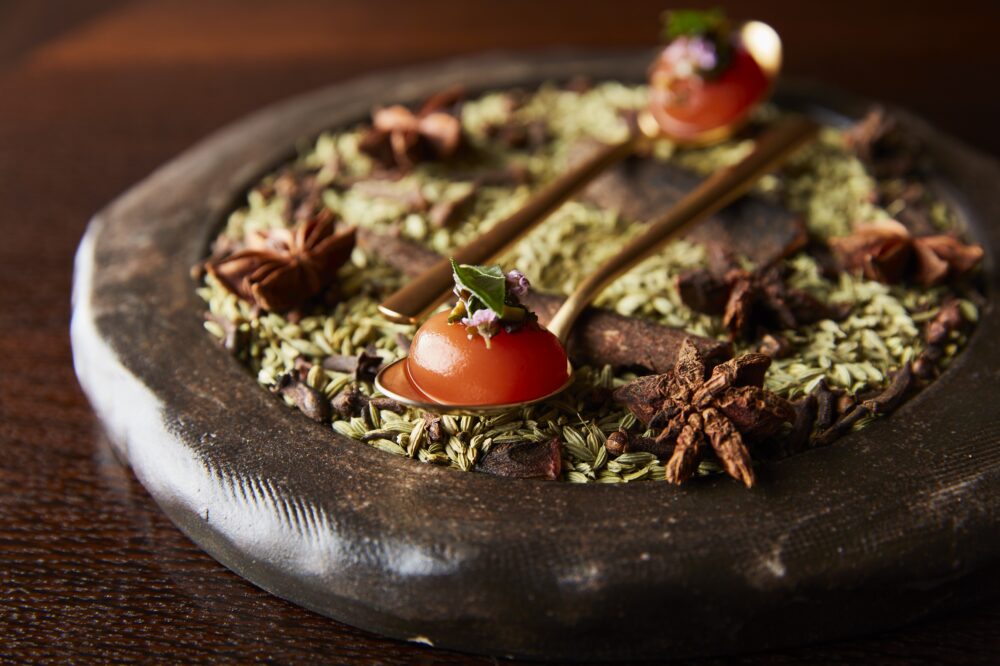A talented, confident new generation of Indian chefs is pushing the boundaries of Indian cuisine, presenting modern interpretations rooted in tradition to audiences across the globe. Tejas Sovani (pictured, right) who staged at Noma, Copenhagen is one of the growing tribe of young chefs who expand their experience at world-renowned restaurants and carry their learnings forward to develop a new way of looking at their own cuisines. Spice Lab Tokyo, conceived by Priya and Sunandan Kapur as a confluence of high-end seasonal Japanese ingredients, Indian cuisine and cooking techniques is a brand-new project, just a year old, located in the heart of the upscale Ginza district of Tokyo. A one-of-a-kind restaurant, the distinctive cuisine is the result of a collaboration between Executive Chef Tejas Sovani, Corporate Chef Ravitej Nath, Consulting Chef Hidemasa Yamamoto and Chef de Cuisine Akira Himukai. The menus at Spice Lab Tokyo are unusual compositions, curated around eleven themes: Temple – an offering; Season – dictated by seasonality; Street – referencing India’s vibrant and extensive range of street foods; Coastline – the long sweeps of Indian coastline that influence cuisine; Contemporary – modern Indian, a reflection of the chef’s travels; Preservation – ancient traditions of pickling and fermentation; Ayurveda – the principles of balance; Home – the comfort foods from home kitchens; Royal – inspired by princely states; Village – forgotten cooking techniques and Festival — referencing India’s many celebrations. In a free-wheeling interview with Chef Tejas Sovani, Kaveri Ponnapa explores the challenges and rewards of marrying Japanese ingredients with Indian flavours to create a unique dining experience for the refined Japanese palate.
In a free-wheeling interview with Chef Tejas Sovani, Kaveri Ponnapa explores the challenges and rewards of marrying Japanese ingredients with Indian flavours to create a unique dining experience for the refined Japanese palate.
After spearheading Amaranta, at The Oberoi Gurgaon, which quickly earned you a reputation for outstanding and innovative contemporary Indian food, what made you take up a post at Spice Lab Tokyo?
The thought of working in Japan was very exciting. I have always worked in hotels all through my career in India and wanted to experience something different. Being a part of the project team, from pre-opening to where we are today, has given me a great opportunity to learn everything about the operation of an independent restaurant, and Japanese culture.
Had you visited in Japan before? What has been your experience of working there, so far?
This is my first time in Japan. I visited the country a couple of times prior to the opening, to understand the diversity of its culture, geography, seasons, and the audience that we would be catering to. I have now been here in Tokyo for just over a year. The experience has been a tremendous learning and growth. It has helped me in understanding the nuances of operating a fine dining restaurant. There is a huge cultural difference which is difficult to adapt to in the beginning, but if you persist and are committed, the rewards are enormous.
Do you speak Japanese? Is it easy to navigate your workspace? How did you approach an understanding of Japanese ingredients and culinary expectations?
I do not speak the language. There are challenges at the workplace, but that’s where the learning is. Every difficult situation also presents you with an opportunity to explore something new. We immersed ourselves for over six weeks in visiting local farms, farmers’ markets and restaurants of different kinds. The Nishiki market in Kyoto was one of the highlights, overflowing with fresh local produce, heritage and culture. I was amazed at the range of pickled foods available, and the traditional Japanese sweets. Seasonal produce comes from Niikura Farms 30 kilometres away, on the outskirts of Tokyo. The Japanese believe in seasonality and they practice it. A lot of attention is paid to the quality of produce. Seldom do you see produce that is non-seasonal. Visiting restaurants serving specialist cuisines such as ramen, yakitori, okonomiyaki and sushi was a major learning, as also my visits to the high-end restaurants, to understand expectations.
What are the Japanese expectations from Indian food? What is the Japanese response to dining at Spice Lab Tokyo?
The popular convenience food of kare raisu, a melange of mass-produced curry roux in blocks, cooked with vegetables and meat, which was introduced to Japan by colonial Britain, is far removed from the kind of food you are creating. In Japan, the awareness of Indian food is extremely limited. People expect the food to be full of chillies and spice. They expect the menu to read “curry” and “naan”. But there is so much more to Indian food. It is not about curry, naan, butter chicken and chicken tikka masala. The diner is pleasantly surprised with the marriage of Japanese ingredients, flavours and Indian spices: for instance, the gol gappa water at SLT is made using umeboshi instead of tamarind to add tartness. The response has been fantastic, as it is a new cuisine for the diners. The philosophy of the restaurant is based on adaptability, with an emphasis on the time of the year (seasons) and the place (Japan). We change our menus every season based on the availability of specific ingredients. Then there is the melding of ingredients: for instance, malai chicken is marinated with saikyo miso; the sauce for wagyu pepper fry is finished with hatcho miso. Foie gras has a generous sprinkle of kadhai spice, and is served with tandoori peach. Spice Lab Tokyo has been appreciated in the ‘Japan Times’, ‘Time Out Tokyo’ and a range of print media.
What have been some of your most appreciated creations?
Clear crab perfumed rasam, oxtail and kujo negi (green onion) biryani, kombu wrapped Wagyu, soramame (broad bean) pepper fry, black pepper and hatcho miso jus (pure soya bean miso) are just some examples of dishes that have been very successful.
Spice Lab combines the finest Japanese ingredients with Indian flavours and techniques. In what way does this change the way you cook or look at the tradition of Indian food?
I think it’s important to understand the tradition of a dish and how it has changed or evolved over a period of time. We break the dish down at various levels and try to find the best possible cooking technique to represent it in a refined way. The hakatajidori is marinated with saikyo miso overnight, washed, dried and sprinkled with malai chicken spices — green cardamom, white pepper and a hint of mace — and then slow cooked for an hour at 56° C, instead of cooking it in cashew miso gravy. This breakdown helps us to keep the flavours of the dish in place and represent it in a finer, more delicate way.
The 11 themes that are the framework for each menu are both elegant and thoughtful, and in many ways echo elements of Japanese culture. How do diners respond to this?
Diners are pleasantly surprised with the themes as they get to experience the depth and diversity of Indian cuisine. Many Japanese who have travelled to India are amazed to see the kind of innovation and variety on offer at Spice Lab Tokyo.
How do you craft the menus? Is it a collaborative effort between Chef Ravitej Nath and you? What is the role of Chef Hidemasa Yamamoto?
The menus are curated primarily keeping in mind seasonal availability. Chef Ravitej guides us through his inputs. Akira Himukai, Chef de Cuisine, plays an important part in understanding and curating the menus along with me. His vast experience of the Japanese palate and exposure to international cuisine helps us balance the nuances of the dish and the menu collectively. Chef Yamamoto helps us refine the menus, bearing in mind very specific Japanese sensibilities and tastes. Based on their feedback, we tweak the menus wherever required.
What do you draw inspiration from? How do you decide to blend flavours and conceive a new dish?
Inspiration comes from across India. The framework of eleven themes helps us in compiling the menu. The flavour blending is based purely on the result we desire to achieve and the inspiration of the dish. Every dish is tried with a minimum of two or three different flavour profiles. The Japanese ingredients are selected according to taste, texture, inspiration of the dish and what impact they would have on the final dish. For instance, slow-cooked abalone, chilli-garlic ajwain butter, kelp and saffron daikon. Even though abalone is not eaten in Indian cuisine, it’s an expensive delicacy in Japan. The textures are at play here: abalone has a bite whereas the daikon is slow cooked till a knife can run through it effortlessly. Then there is slow-cooked ox tail and kujo negi (Japanese green onion) biryani inspired by traditional Hyderabadi beef biryani, served with Burrani Raita. The use of brown onions has been replaced by kujo negi which makes it look fresh, and also makes the biryani lighter.
Were there any dishes that did not work out? What were some of the outstanding dishes?
There were many dishes which bombed completely and never made it to the menu! For instance, ise ebi (Japanese spiny lobster) with saikyo miso, kasundhi, caviar and uni (sea urchin) seemed to be very chaotic, as the taste of ise ebi was lost. Shime saba (cured mackerel) in a Kerala style curry was too strong and fishy. On the other hand, kadhai spiced foie gras, peach glass and tandoori peas, rasam wada, shiso (perilla leaves) chutney, tomato chutney and coconut charcoal jelly were very successful.
Do you think that Spice Lab, as a concept, will raise international perceptions of the possibilities of Indian cuisine?
As a concept it is extremely fluid, using what is on hand, keeping adaptability in mind. This helps us to experiment to a greater extent. It will definitely change the perception favourably towards Indian cuisine in the international market.
Is Spice Lab Tokyo the only restaurant of its kind in Japan, or are there other Indian restaurants with a similar philosophy?
Spice Lab Tokyo opened on 16th November, 2019. At present, this is the only restaurant of its kind.
This article appeared in Sommelier India, Issue – Summer 2021.




